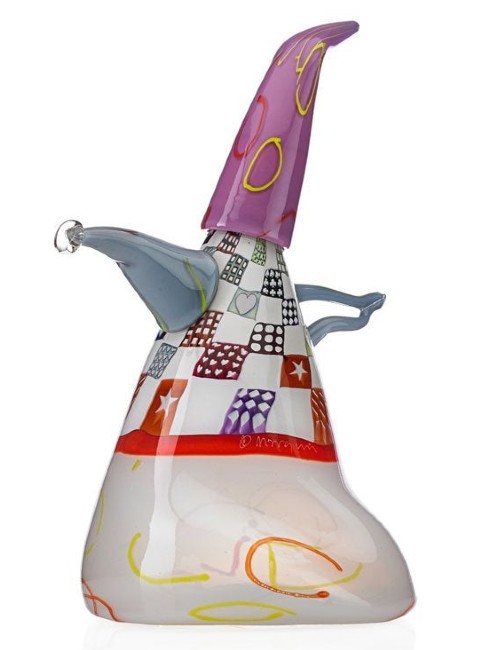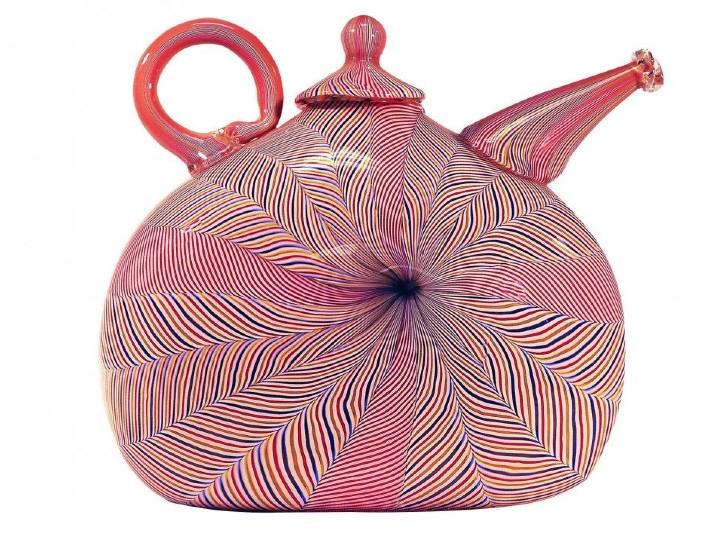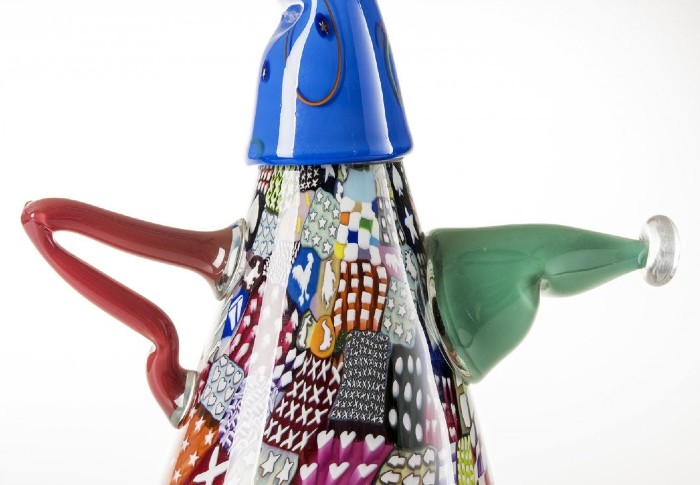
NEW YORK – Richard Marquis (b. 1945) has always been a collector, scavenging bottle caps and stray objects as a child, and his collecting has made its way into his artworks, which seem to meld disparate pieces into his glass constructions. A devotion to upending historical glass traditions is especially striking in his “crazy quilt” teapots. These works are particularly emblematic of the artist’s style, which blends whimsy and humor, a strong sense of color and a burning desire to experiment.
As a teenager in Southern California, he pursued his interest in ceramics, no doubt picked up from his mother, a ceramics hobbyist. Later, he studied in Berkeley with masters such as Peter Voulkos, but increasingly became fascinated with glassblowing. By 1969, he was awarded a fellowship to study in Murano, Italy, where he was introduced to murrine glass and other traditional glassmaking techniques.
His early introduction to glassblowing in California was refined by the time he spent in Venice, studying with master glass artisans there and these two worlds combined in his art. The funky-hippie Berkeley aesthetic and art scene he immersed himself in there and the revered European traditions merged to guide his vision of glassmaking that is both classical and sophisticated yet modern and inventive.

A leader in the studio glass movement, Marquis has been well represented in many museum and gallery exhibitions and he has taught extensively around the world, eagerly sharing his expertise with fellow artists and students. He has earned several lifetime achievement awards, including one from the Glass Art Society in 2005.
Murrine glass has figured prominently into many of his works, and he was an early pioneer of this technique, well before many of his American counterparts. Murrine glass refers to the technique of creating multicolored elements in a long rod of glass that reveals infinite designs when cut into cross-sections. Murrine was an especially useful technique in his iconic teapots, which are said to be a favorite form for the artist. Among his teapots is a series that was inspired by American crazy quilts.

“Although Marquis uses traditional Venetian decorative techniques, his work in glass is never mistaken for Venetian,” wrote Tina Oldknow, former modern and glass senior curator at the Corning Museum of Glass in upstate New York, who retired in 2015. She noted his works are a distinctly American adaptation instead of being a direct replication of the Venetian style.
The Museum of Glass in Tacoma, Washington, presented a 2019-20 exhibition, “Keepers,” highlighting the artist’s “extraordinary technique, comic sensibility, bold innovations and iconoclastic spirit.” In a press release, Benjamin Cobb, the museum’s Hot Shop director, said. “It’s one thing to be incredibly skilled and have an eye for details, but it’s what Richard Marquis does with the work after the pipe that brings humor and context to it. His ability to create work that pulls the view away from the overwhelming mastery of technique is something I’ve always found astounding.”

Harnessing his aptitude and skill with both ceramics and glass, the artist has created a staggering body of work in several series and teapots remains one of his signature forms. The visual vocabulary the artist employs is influenced by his lifelong penchant for collecting odd and found objects from ceramic dogs to cigar bands and tin coffeepots. Among his teapots in museum collections are this wizard teapot in the Smithsonian American Art Museum and this one at the Rockford (Illinois) Art Museum or this teapot with skulls and bunnies at the Philadelphia Museum of Art.
From standard-form decorative teapots to teapots placed atop wheels or a stack of donuts or even a teapot underneath an oversized goblet, Marquis has elevated the ordinary to new heights much in the way that Warhol did for soup cans and Brillo pads. The Kamm Teapot Foundation has over 100 of Marquis’ works in its collection, such as this “Lumpyware” teapot.

“As an artist, Marquis is admired for his sophisticated understanding of color and form as much as for his humor and willingness to experiment,” according to Schantz Galleries in Stockbridge, Massachusetts, noting on its website that the artist has been an influential glassblower inspiring a generation of glass artists with his unique vision and technical mastery.
In Marquis’ hands, his teapots assume new identities, even political statements. Their delicate nature is in stark contrast to the strong explosions of color and texture exuding from their glass surfaces.
Marquis continues to work quietly from his Puget Sound studio in the Pacific Northwest, letting his art speak for itself. The versatility of murrine glass as a medium continues to fascinate both the artist and collectors, who appreciate his inventive creations.



